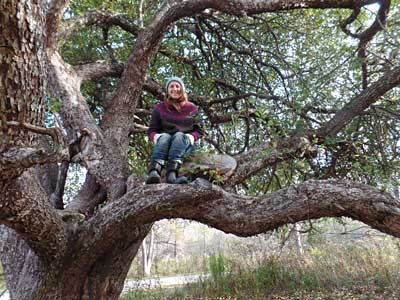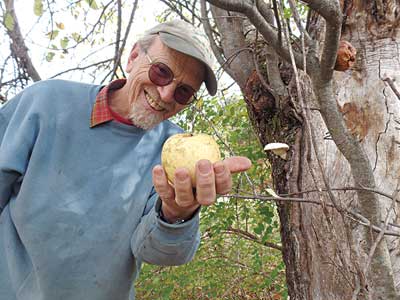 |
| The author in a Grasslings tree. Photo by John Bunker |
 |
| John Bunker with one of the Blake candidates. Photo by Laura Sieger |
By Laura Sieger, MEHO Intern
In 2016, MOFGA’s Maine Heritage Orchard (MEHO) had another successful year. In April we planted 55 more heirloom varieties that were new to the orchard. From June through October MOFGA apprentices Nick Libby, Kelsey McGrath and I led a weekly volunteer day at the orchard. We weeded around each tree, planted additional orchard companions, and did a lot of watering. Most of the trees and companions seem to have fared well, despite severe drought. Insect pests were plentiful; we manually removed many from leaves and twigs, and recorded the damage in our journals for comparisons in future years. Eventually we will use a comprehensive, holistic orchard health regimen, applying neem oil to the trunks of young trees to defend against borers, and later a mix of fish, kelp and effective microbes to promote healthy tree growth while discouraging disease. We’ll apply kaolin clay in spring and summer to protect developing fruits from a variety of pests.
A few years ago this area was a gravel pit stripped of almost all life. Now most of the orchard is covered with vegetation. The clover we seeded in 2014 was lush and filled with buzzing bees all summer, and many of the woody companion plants – elderberries, blueberries, willows, etc. – are doing well.
On the last 2016 workday – our annual Compost Day in October – we prepared sites for 30 new trees with a mixture of soil amendments and compost and then put tree guards on all 230 existing trees. In November we put the remaining guards on trees in MOFGA’s North and South Orchards for protection from voles, which often girdle fruit trees in winter when food is scarce. We recommend using tree guards every year until fruit trees are mature. Plastic spiral guards cost about $1 each; a section of screening tied tightly around the trunk with string also works. Be sure to remove tree guards, whether plastic or screening, in spring.
Later in the fall we collected fruit and visited old orchards around Maine. We have been identifying varieties and discovering new candidates for planting in the orchard.
We have also been working with Jesse Watson of Midcoast Permaculture Design on a plan to shape and terrace another large section of the MEHO site. Renovations should occur this summer. We will seed the newly shaped terraces with ground cover, including clover, and starting in 2018 we will plant the terraces with rows of fruit trees and hundreds of companions.
This spring we will plant another 30 trees, including Royal Sweet propagated from Rollins Orchard in Garland. The majestic, wide and spreading tree stands in a field near a former farmhouse on the Rollins property. Seeing that Royal Sweet tree for the first time in 2014 was one of the best fruit exploring trips that year.
In November 2016, John Bunker and I visited an ancient seedling tree in Down East, Maine, that reminded me of the Royal Sweet’s wonderful spreading shape and enormous size. The owners, who live down shore of the Bagaduce River, named the tree “Grasslings,” and we fell in love with this beauty. Bunker and some friends returned in December to collect several bushels of Grasslings fruit for cider.
A few of our fruit exploring trips last fall were more specific historical missions. We were searching for apples for which we have names and records but whose fruit we have yet to see. We poked around on old farm roads in Bowdoinham and Topsham for an apple called Givens. After meeting some wonderful people who led us to the historical society, we were shown a book that was mostly a transcribed diary from an 1800s grafter named Abraham Preble. We searched for clues in it and have been asking around to find out if anyone has seen an ancient tree with purple-red conic apples hanging on late in the season. On another of our fall fruit exploring adventures, we searched for the Blake apple and found several candidates at two old Blake farms in Brownfield. Blake is a wonderful pale to bright yellow with hints of green and nice patches of netted russet – a delicious fresh eating and cooking apple once popular in Gorham and points west.
The trees we plant this spring, like all others previously planted at MEHO, will be just over 2 years old. We collect scionwood in the winter, graft trees in early spring onto standard-sized, hardy Antonovka rootstock to preserve the varieties for a long life, then grow them in a nursery for two years. We dig them in fall and store them through winter to be planted in April. They should still be going strong in 150 years. Dwarf and semi-dwarf trees have a much shorter lifespan.
Our stewardship program “backs up” each variety growing in the Heritage Orchard. For $50 you can purchase a steward tree to plant wherever you like – in your yard, at a historical society, at schools. Your duplicate tree can provide scionwood if anything happens to its MEHO twin. Steward trees not only help preserve varieties but reintroduce them in their original communities and, we hope, will make them commonplace again.
Read more about MEHO or contact us at [email protected] or visit the MEHO website
